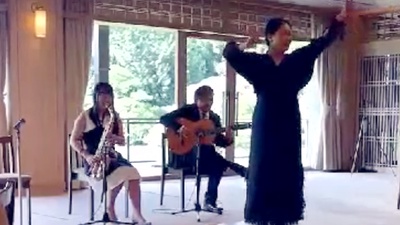Track List
※ Preview may take some time.
※ Preview is not available for songs under copyright collective.
A rare live version of Romera's songs 1 and 2, as well as the escobilla (the part that shows off the dancer's foot technique). May 17, 2014, Nerima Cultural Center. Powerful and sophisticated zapateado (footsteps) that stands out. A guitar sound with instant power and improvisation. The dialogue between the highly original arrangement and traditional formal beauty is beautiful.
Dance: Atsuko Miyamoto. Guitar: Katsuhiko Katagiri. Others: Estudio ROMERO
Artist Profile
Atsuko Miyamoto
Flamenco bailaora. Born in Osaka in 1971. She started playing the piano when she was a child, and when she was in high school, she belonged to a jazz band in Florida, USA, where she studied abroad. Started flamenco in a circle while attending the Department of Newspapers, Faculty of Letters, Sophia University (instructed by Hanae Sekiguchi). After graduating, while working as a magazine editor, studied under Sachiko Setta and Yumi Onimoto. After studying abroad in Spain for a short period in 1992 and 1995, she studied flamenco for a long time from 1998 to the end of 2000. Studied under Juana Amaya,Andres Marin, Beren Fernandez, La China, Calmera Greco, etc. After returning to Japan, she presided over Estudio ROMERO.
Atsuko Miyamotoの他のリリース
![Escobilla para SOLEÁ (feat. Conjunto ROMERO & Katsuhiko Katagiri) [Live at Nakano ZERO, Tokyo, 2021] Front Cover](https://tcj-image-production.s3.ap-northeast-1.amazonaws.com/u132807/r860633/ite860633.jpg?X-Amz-Algorithm=AWS4-HMAC-SHA256&X-Amz-Credential=AKIAJV4VIS2VN3X4CBGA%2F20250221%2Fap-northeast-1%2Fs3%2Faws4_request&X-Amz-Date=20250221T104145Z&X-Amz-Expires=86400&X-Amz-SignedHeaders=host&X-Amz-Signature=784dd82913881ff8c750945109be1049cf106ac6f25d31912237fe0a9c3b28a0) Escobilla para SOLEÁ (feat. Conjunto ROMERO & Katsuhiko Katagiri) [Live at Nakano ZERO, Tokyo, 2021] Atsuko Miyamoto
Escobilla para SOLEÁ (feat. Conjunto ROMERO & Katsuhiko Katagiri) [Live at Nakano ZERO, Tokyo, 2021] Atsuko Miyamoto![Escobilla para SIGUIRIYA (feat. Conjunto ROMERO & Katsuhiko Katagiri) [Live at Nerima Bunka, Tokyo, 2015] Front Cover](https://tcj-image-production.s3.ap-northeast-1.amazonaws.com/u132807/r908611/ite908611.jpg?X-Amz-Algorithm=AWS4-HMAC-SHA256&X-Amz-Credential=AKIAJV4VIS2VN3X4CBGA%2F20250221%2Fap-northeast-1%2Fs3%2Faws4_request&X-Amz-Date=20250221T104145Z&X-Amz-Expires=86400&X-Amz-SignedHeaders=host&X-Amz-Signature=6f40c8c46cecb6b8837f084f9bd86e61de249d7fdd19c1c2cc972e13f7f48e94) Escobilla para SIGUIRIYA (feat. Conjunto ROMERO & Katsuhiko Katagiri) [Live at Nerima Bunka, Tokyo, 2015] Atsuko Miyamoto
Escobilla para SIGUIRIYA (feat. Conjunto ROMERO & Katsuhiko Katagiri) [Live at Nerima Bunka, Tokyo, 2015] Atsuko Miyamoto Alegrías - flamenco at a wedding (Live at Meiji Kinenkan, 2022) Atsuko Miyamoto, Amin Katagiri, Katsuhiko Katagiri & Conjunto ROMERO
Alegrías - flamenco at a wedding (Live at Meiji Kinenkan, 2022) Atsuko Miyamoto, Amin Katagiri, Katsuhiko Katagiri & Conjunto ROMERO Escobilla para Tiento (Live at Nerima Bunka, 2011) Atsuko Miyamoto & Katsuhiko Katagiri
Escobilla para Tiento (Live at Nerima Bunka, 2011) Atsuko Miyamoto & Katsuhiko Katagiri
Katsuhiko Katagiri
Katsuhiko Katagiri Flamenco guitarist. Born in Atami, Shizuoka Prefecture in 1966, raised in Tokyo. He started to play violin from a young age, and then he studied guitar alone. He formed Rock Group A-JARI in junior high school and won a contest sponsored by YAMAHA. After that he went through jazz guitar and studied folk music of the world at Meiji University Ebato Akira seminar. In addition, he started playing flamenco guitar while studying, and studied under Hideo Suzuki. In 1988, after studying abroad for a short period in Spain, he has been active in flamenco classes, theaters and tablaos, etc., mainly on dance accompaniment. Long-term study abroad in Spain in 1998. Studied with Miguel Angel Cortes, Paco Arriaga, etc. In addition to the local tablao and radio appearances, it has been well received by Jana Amaya's classroom accompaniment. After returning to Japan at the end of 2000, along with dance accompaniment, he has also put emphasis on teaching younger generations, co-starring with other genres and presides over Estudio ROMERO.
Katsuhiko Katagiriの他のリリース
![Yasashisa ni tsutsumareta nara (feat. Amin Katagiri) [Live at San azeria hall, 2020] Front Cover](https://linkcore-image.kicks.video/TCJPMVR0000820901/linkcore_image.jpg?width=400) Yasashisa ni tsutsumareta nara (feat. Amin Katagiri) [Live at San azeria hall, 2020] Conjunto ROMERO, Amin Katagiri, Ramon Katagiri & Katsuhiko Katagiri
Yasashisa ni tsutsumareta nara (feat. Amin Katagiri) [Live at San azeria hall, 2020] Conjunto ROMERO, Amin Katagiri, Ramon Katagiri & Katsuhiko Katagiri Alegrías - flamenco at a wedding (Live at Meiji Kinenkan, 2022) Atsuko Miyamoto, Amin Katagiri, Katsuhiko Katagiri & Conjunto ROMERO
Alegrías - flamenco at a wedding (Live at Meiji Kinenkan, 2022) Atsuko Miyamoto, Amin Katagiri, Katsuhiko Katagiri & Conjunto ROMERO Escobilla para Tiento (Live at Nerima Bunka, 2011) Atsuko Miyamoto & Katsuhiko Katagiri
Escobilla para Tiento (Live at Nerima Bunka, 2011) Atsuko Miyamoto & Katsuhiko Katagiri
Estudio ROMERO




























































